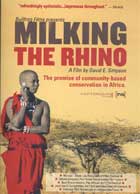
Milking the Rhino 2008
Distributed by Bullfrog Films, PO Box 149, Oley, PA 19547; 800-543-FROG (3764)
Produced by David E. Simpson
Directed by David E. Simpson
DVD, color, 54 and 83 min. (reviewed) versions
Jr. High - Adult
African Studies, Conservation, Environmental Studies, History, Community Studies
Date Entered: 07/31/2009
Reviewed by Janis Tyhurst, Reference Librarian, George Fox UniversityAll too often the news about Africa is about all the problems occurring on the continent, giving the impression that Africans just aren’t up to the task of taking care of themselves or their countries. This documentary provides a more realistic vision of African life in two countries that are successfully managing community based conservation efforts. The story, cinematography, film editing, and sound quality are all excellent. It is a concise comprehensive look at successful conservation efforts that are African led. It explores multiple issues—environmental conservation, community development, cultural anthropology, African history and politics, tourism and ecotourism. It provides a balanced picture of the issues and concerns and how they are being worked out. It is a story of hope and forgiveness, of people moving beyond the past and working together to build a sustainable future. The documentary spotlights two cattle herding cultures from the East and West sides of the continent, the Masai in Kenya and the Himba in Namibia, who have been working towards diversifying their business/culture and are doing so through developing successful environmental tourism projects that include a lodge and wildlife tours.
For the past 10 years, the Masai have built up a tourism trade that embraces wildlife conservation without giving up one of the major sources of cultural identity—cattle herding, yet they have limited cattle grazing to only 20% of their territory with the remaining 80% going for wildlife conservation. They are looking towards the future where cattle herding, although central to their culture, will not be the financial mainstay that it was in the past. The history of the lodge development is given while various Masai talk about their part in the development and share their thoughts of the value of the whole enterprise. And just like many towns in the US, not everyone is happy about the changes that have been made. The documentary does a good job of providing a balanced view of these conservation efforts, giving equal time to those for or against the project. Late in the documentary, a neighboring 4th generation white rancher, Ian Craig, is introduced along with the history between Craig’s family and the Masai. Twenty years ago, there were violent conflicts between Craig and the Masai over cattle rustling. Craig turned to tourism both as a means to end the conflict and maintain his ranch. As the tensions decreased and the Masai started looking into wildlife conservation, they asked Craig to advise them. As time has passed, the tensions have dissipated and Craig has become a valued advisor to the Masai.
In Namibia, multiple groups are working together to rebuild after the savage and destructive civil wars that occurred during the 1980s. Much of the wildlife was decimated and landmines were everywhere. In the Namibian constitution, Article 95 specifically addresses the preservation of the environment and wildlife in a sustainable manner for present and future generations. Again the documentary provides a balanced view of the situation. As in the U.S., environmental protections can restrict traditional activities, causing friction between those that want change and those that don’t. Several issues are shown—one problem is environmental degradation through overgrazing, another is lions killing cattle. The documentary follows the resolution of these problems. In the case of the lions, one cattle herder defends his killing of four lions at the annual meeting (of all the environmental stakeholders), sounding very much like ranchers in the Western U.S. discussing wolves. Another Namibian rebuts the cattle herder by telling him that if he had gone to the council, they could have solved the problem by first identifying the lion(s) killing cattle and then sold the hunting rights to a tourist which would have brought a significant amount of money into the community.
Included in the documentary is the history of wildlife park development in Africa. There are some archival films of the development and promotion of these wildlife parks. Paralleling the displacement of the Native Americans in the U.S. from their homelands, Africans were also displaced from traditional lands that were turned into big game hunting preserves. One chilling archival films talks about removing the “squatters” so that a whites only wildlife park could be created. Africans caught hunting or killing any wildlife were severely prosecuted.
The DVD includes three 20 minute thematic modules for easier classroom breakout of particular issues:
- Profiting from Conservation;
- Human-Wildlife Conflicts;
- Grazing.
- Director's Award for Best Documentary Feature, Pan African Film Festival
- Best Documentary, San Luis Obispo International Film Festival
- Joris Ivens Award Competition, International Documentary Film Festival Amsterdam
- Silver Lei Winner, Honolulu Film Festival